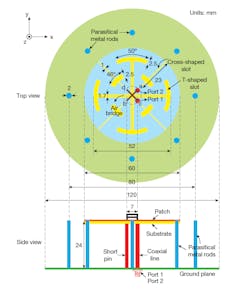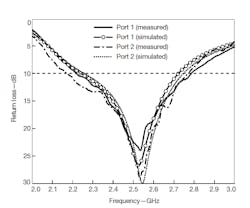Slot Antenna Uses Dual Polarization
This file type includes high resolution graphics and schematics when applicable.
Dual-polarized antennas have often brought exceptional performance to wireless communications systems, at the same time reducing occupied space in wireless base stations. While a variety of dual-polarized antenna designs have been developed for this purpose,1-12 there is always room for improvement. With that goal in mind, the current researchers developed a novel dual-polarized broad beamwidth slot antenna with low cross-polarization and high isolation.
This design features special T-shaped and cross-shaped slots to achieve symmetrical radiation patterns at slanted ±45-deg. polarization angles, and with low cross-polarization between the radiation patterns. High isolation between the two feeding ports is accomplished by means of two shorting pings, and the beamwidth is broadened by placing eight upright parasitical metal rods around the antenna. The antenna’s frequency coverage of 2.26 to 2.75 GHz makes it suitable for WiMAX applications.
Dual-polarized antennas are often used in wireless communications systems to enhance signal reception quality. Compared with the use of space diversity, a dual-polarized antenna can help effectively reduce the space occupied by the antenna systems in a wireless base station. Dual-polarized antennas have been realized by means of several different design approaches—for example, achieving high input-port isolation and wide bandwidth when using aperture coupling feeds.1-6 But this type of antenna suffers from obvious cross-polarization radiation caused by higher-order-mode transverse currents, which degrades the discrimination between the two linear polarizations.
To reduce cross-polarization, a number of other feed types have been reported.7-12 It has been found that higher-order modes can be suppressed when the antenna is symmetrically excited by a dual-feed system with a phase difference of 180 deg.7-10 If a meandering probe11,12 is employed instead of a straight probe, the probe radiation can be further reduced. Unfortunately, while these antennas exhibit lower cross-polarization than the aperture coupling types, they require much more complex structures and may not be practical for all engineering applications.
Some wireless applications, such as WiMAX, pose rigorous requirements in terms of broad bandwidth, along with the need for the system antennas to provide a uniform response over approximately the entire upper hemisphere and stable gain at a low angle. These demands call for tight control of radiation characteristics, and a number of design methods have been documented accordingly. These include the use of loading gaps and stubs,13 incorporating a corner reflector,14 and applying a microstrip dielectric structure.15 But broad-bandwidth techniques have seldom been associated with dual-polarized-antenna designs.
As will be shown, however, it is possible to obtain broadband frequency operation with a dual-polarized-antenna design. The antenna, excited by two coaxial-line feeds, is composed of four T-shaped slots and four cross-shaped slots in the radial directions of a circular patch. Eight upright parasitical rods are placed around the antenna to realize a broad beamwidth radiation pattern. The antenna yields an impedance bandwidth of 20% (2.26 to 2.75 GHz) centered at 2.5 GHz—with port isolation of better than 36 dB and cross-polarization of less than –35 dB—and is expected to operate well for WiMAX applications.
Figure 1 shows the geometry of the proposed dual-polarized antenna. To produce the antenna, a symmetrical slot patch radiator is printed on a 1-mm-thick FR-4 printed-circuit-board (PCB) substrate with relative permittivity of 4.65. The circle patch and the ground plane have diameters of 60 and 120 mm, respectively. Four T-shaped slots and four cross-shaped slots are embedded into the circular patch to achieve compact size and good dual-polarized radiation performance.
The antenna is fed by two coaxial lines located at a radial distance of 7[(2)0.5/2] mm from the center. The outer conductor, a single coaxial line, is directly connected to point a, while the inner conductor in bent for connection to point b. Similarly, the other coaxial line is connected to points c and d. These type of structures are used to form to air crossover bridges. The two linear polarizations at the two antenna ports are along these two air crossover bridges. To improve the isolation between the two input ports, two short pins connected to points b and d have been added to the design.
The height from the ground to the patch is 24 mm (approximately one quarter of the free-space wavelength at the center frequency), used for high gains and excitation of the balanced mode without a balun structure. In addition, eight upright parasitical metal rods were employed to broaden the beamwidth; they are placed around the slot patch and located at a radial distance of 40 mm from the center. The antenna design exhibits dual linear polarizations at slanted ±45-deg. angles with the directional beamwidth about 108 deg. at the E-plane and 92 deg. at the H-plane of the antenna. The -45-deg. polarization is excited by port 1, while the 45-deg. polarization is excited by port 2. Each antenna port has one end connected to the patch and the other end connected to a 50-Ω coaxial SMA connector.
1. This diagram shows the geometry of the proposed dual-polarized antenna, as well as how the T-shaped and cross-shaped slots are formed. The antenna is fabricated from low-cost FR-4 PCB substrate material.
Based on the detailed dimensions of Fig. 1, a prototype dual-polarized antenna was designed and fabricated, and its performance subsequently evaluated. The design was aided by the commercial three-dimensional (3D) full-wave electromagnetic (EM) simulation software, ANSYS HFSS (High-Frequency Structure Simulator), which is based on finite-element (FE) analysis. Figures 2 and 3 show simulated and measured curves of return loss and isolation, respectively, for the proposed antenna. As the results show, fair agreement was obtained between the measured and simulated data. The resonant mode was activated to achieve good impedance matching for a bandwidth of 490 MHz (from 2.26 to 2.75 GHz), based on a criterion of better than 10-dB return loss to successfully cover the 2.5-GHz band used for WiMAX applications. Measured isolation between the two antenna ports was better than 36 dB across the full desired bandwidth.
2. These plots show the simulated and measured return-loss characteristics at antenna ports 1 and 2 from 2 to 3 GHz.
3. These plots show the simulated and measured isolation characteristics at antenna ports 1 and 2 from 2 to 3 GHz.
The dual-polarized slot-antenna design was also tested in a far-field chamber. Figure 4 shows the measured normalized radiations in the E-plane (slanted -45-deg. vertical cross-section) and H-plane (slanted 45-deg. vertical cross-section) at a test frequency of 2.5 GHz. The antenna radiates in a broadside direction and features almost symmetrical radiation patterns in both the E- and H-plane directions. As Fig. 4 shows, the antenna’s cross-polarization remains under -35 Db; the front-to-back ratio is less than 18 dB; and the half-power beamwidth is about 108 deg. in the E-plane and 92 deg. in the H-plane. Peak gains for the antenna were also measured at several discrete frequencies across its operating bandwidth. For that bandwidth, the average gain was about 6.3 dBi.
4. These plots show the simulated and measured E-plane (left) and H-plane (right) radiation patterns for the novel dual-polarized antenna.
In summary, a novel dual-polarized slot antenna with two coaxial feed lines was designed and fabricated. By using special slots in its circular patch radiator and short pins between the patch and the ground plane, the antenna realizes low cross-polarization of under -35 dB while also achieving high isolation of better than 36 dB. To enhance performance, eight upright parasitical metal rods were added to broaden the antenna’s beamwidth. The measured results of the fabricated antenna prototype show good agreement with computer-aided-engineering (CAE) software simulations using a commercial program. The novel antenna design is extremely compact—with symmetrical radiation patterns characterized by broad beamwidth, and stable gain of about 6.3 dBi across the desired operating band—making it suitable for WiMAX applications.
Wei Hu, Doctor
Xi Yang, Doctor
Ying-Zeng Yin, Professor
Wei-Jun Wu, Doctor
National Key Laboratory of Science and Technology on Antennas and Microwaves, Xidian University, Xi’an, Shaanxi 710071, People’s Republic of China; e-mail (Wei Hu): [email protected]
References
1. K. Ghorbani and R.B. Waterhouse, “Dual polarized wide-band aperture stacked patch antennas,” IEEE Transactions on Antennas and Propagation, Vol. 52, 2004, pp. 2171-2174.
2. K.-L. Wong, H.-C. Tung, and T.-W. Chiou, “Broadband dual-polarized aperture-coupled patch antennas with modified H-shaped coupling slots,” IEEE Transactions on Antennas and Propagation,Vol. 50, 2002, pp. 188-191.
3. M. Kaboli, S.A. Mirtaheri, and M.S. Abrishamian, “High-isolation X-polar antenna,” IEEE Antennas andWireless Propagation Letters, Vol.9,2010, pp. 401-404.
4. A.A. Serra, P. Nepa, G. Manara, G. Tribellini, and S. Cioci, “A wide-band dual-polarized stacked patch antenna,” IEEE Antennas and Wireless Propagation Letters, Vol. 6,2007, pp. 141-143.
5. X.-L. Liang, S.-S. Zhong, and W. Wang, “Design of a high isolation dual-polarized slot-coupled microstrip antenna,” Microwave and Optical Technology Letters,Vol. 47, 2005, pp. 212-215.
6. S. Gao and A. Sambel, “Broadband dual-polarized proximity coupled circular patch antenna,” Microwave and Optical Technology Letters, Vol. 47, 2005, pp. 298-302.
7. Z.N. Chen and M.Y.W. Chia, “Experimental study on radiation performance of probe-fed suspended plate antennas,” IEEE Transactions on Antennas and Propagation,Vol. 51,2003, pp. 1964-1971.
8. X.Y. Zhang, Q. Xue, B.J. Hu, and S.L. Xie, “A wideband antenna with dual printed L-probes for cross-polarization suppression,”IEEE Antennas andWireless Propagation Letters, Vol. 5, 2006, pp. 388-390.
9. C.H.K. Chin, Q. Xue, H. Wong, and X.Y. Zhang, “Broadband patch antenna with low cross-polarisation,” Electronics Letters,Vol. 43, 2007, pp. 137-138.
10. A. Petosa, A. Ittipiboon, and N. Gagnon, “Suppression of unwanted probe radiation in wideband probe-fed microstrip patches,” Electronics Letters,Vol. 35, 1999, pp. 355-357.
11. P. Li, H.W. Lai, K.M. Luk, and K.L. Lau, “A wideband patch antenna with cross-polarization suppression,” IEEE Antennas and Wireless Propagation Letters, Vol. 3, 2004, pp. 211-214.
12. C.-Y.-D. Sim, C.-C. Chang, and J.-S. Row, “Dual-feed dual-polarized patch antenna with low cross polarization and high isolation,” IEEE Transactions on Antennas and Propagation,Vol. 57,2009, pp. 3321-3324.
13. Z.-S. Duan, S.-B. Qu,Y. Wu,J.-Q. Zhang, “Wide bandwidth and broad beamwidth microstrip patch antenna,” Electronics Letters,Vol. 45, 2009, pp. 249-250.
14. Z. Zaharis, E.Vafiadis, and J.N. Sahalos, “On the design of a dual-band base station wire antenna,” IEEE Antennas and Propagation Magazine, Vol. 42, 2000, pp. 144-151.
15. H. Haida, “A novel wide beam circular polarization antenna-microstrip-dielectric antenna,” 3rd International Conference on Microwave and Millimeter Wave Technology Proceedings, 2002.pp. 381-384.
This file type includes high resolution graphics and schematics when applicable.





